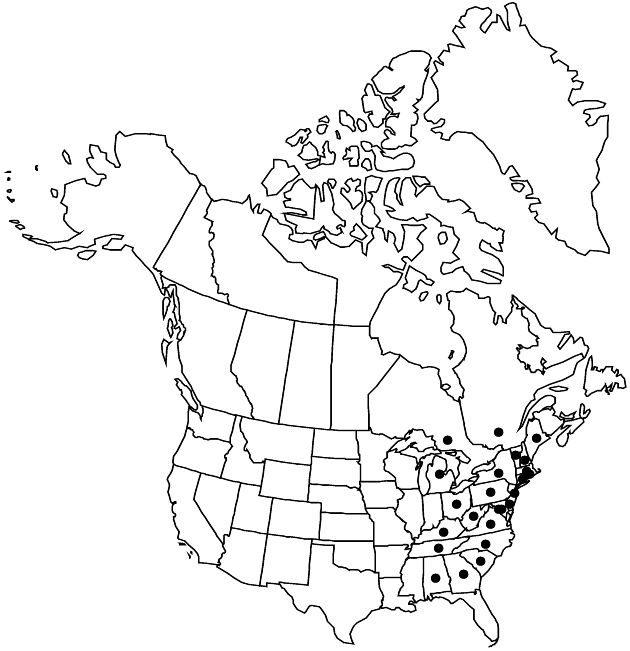Eurybia divaricata
Phytologia 77: 259. 1995.
Plants 28–90 (–120) cm, in ± dense clones (lacking sterile rosettes); rhizomes branched, elongate, becoming woody. Stems 1, erect, simple, flexuous, glabrate to sparsely puberulent proximally, densely puberulent distally. Leaves basal and cauline, thin, margins sharply serrate, teeth (6–15 per side) mucronulate, ciliate, apices acuminate, abaxial faces sparsely strigose or villous, particularly villous along veins, adaxial glabrescent to sparsely strigose, veins sparsely stipitate-glandular; basal and proximal withering by flowering, petiolate (petioles 20–70 mm), blades ovate, 19–65 × 17–60 mm, basal smaller than proximal, bases cordate (sinuses narrow, curved); cauline petiolate, petioles often ± winged (15–70 mm), blades ovate, 20–200 × 10–100 mm, bases cordate to rounded; distal (arrays) usually sessile, sometimes subpetiolate, blades ovate to lanceolate, 5–20 × 1–8 mm, bases rounded. Heads 4–50 (–100+) in ± flat-topped corymbiform arrays. Peduncles to 1.5 cm, densely hairy, eglandular; bracts 0 (–2). Involucres cylindro-campanulate, 4.2–6 mm, much shorter than pappi. Phyllaries 25–30 in 4–5 series, inner purplish distally, oblong (outer) to lanceolate or linear-lanceolate (inner), strongly unequal, bases indurate, green zones in distal 1/2 (outer) to 1/3 or along distal midveins (inner), margins narrowly scarious, densely fimbriate-ciliate, apices rounded to acute, faces sparsely hairy, sometimes sparsely stipitate-glandular; outer 0.7–1.5 mm wide, lengths seldom more than 2.5 times widths. Ray-florets 5–10 (–12); corollas white, 6–12 × 1.5–2.2 mm. Disc-florets 12–19 (–25); corollas yellow, 4.1–4.8 (–5.5) mm, abruptly ampliate, tubes (2.3–2.6 mm) longer than campanulate throats (0.9–1.2 mm), lobes reflexed, lanceolate, 0.7–1.4 mm. Cypselae brown, cylindro-obovoid, slightly compressed, 2.6–3.8 mm, ribs 7–10 (tan to stramineous), faces sparsely strigillose; pappi of reddish to cream-colored (fine, barbellulate, sometimes apically ± clavate) bristles 3.7–5 mm, equaling or longer than disc corollas. 2n = 18.
Phenology: Flowering late summer–fall.
Habitat: Dry to mesic, eastern deciduous and mixed deciduous woods, edges and clearings, roadsides
Elevation: 0–1200(–1700) m
Distribution

Ont., Que., Ala., Conn., Del., D.C., Ga., Ky., Maine, Md., Mass., Mich., N.H., N.J., N.Y., N.C., Ohio, Pa., R.I., S.C., Tenn., Vt., Va., W.Va., in Europe (Netherlands)
Discussion
Eurybia divaricata is a mainly Appalachian element of the eastern North American deciduous forest. It is often confused with Eurybia chlorolepis (see W. F. Lamboy 1992 for distinction between the two species), E. schreberi, or Symphyotrichum cordifolium. Lamboy provided a map of the species.
Selected References
None.
Lower Taxa
"[" is not declared as a valid unit of measurement for this property."]" is not declared as a valid unit of measurement for this property."thin" is not a number.